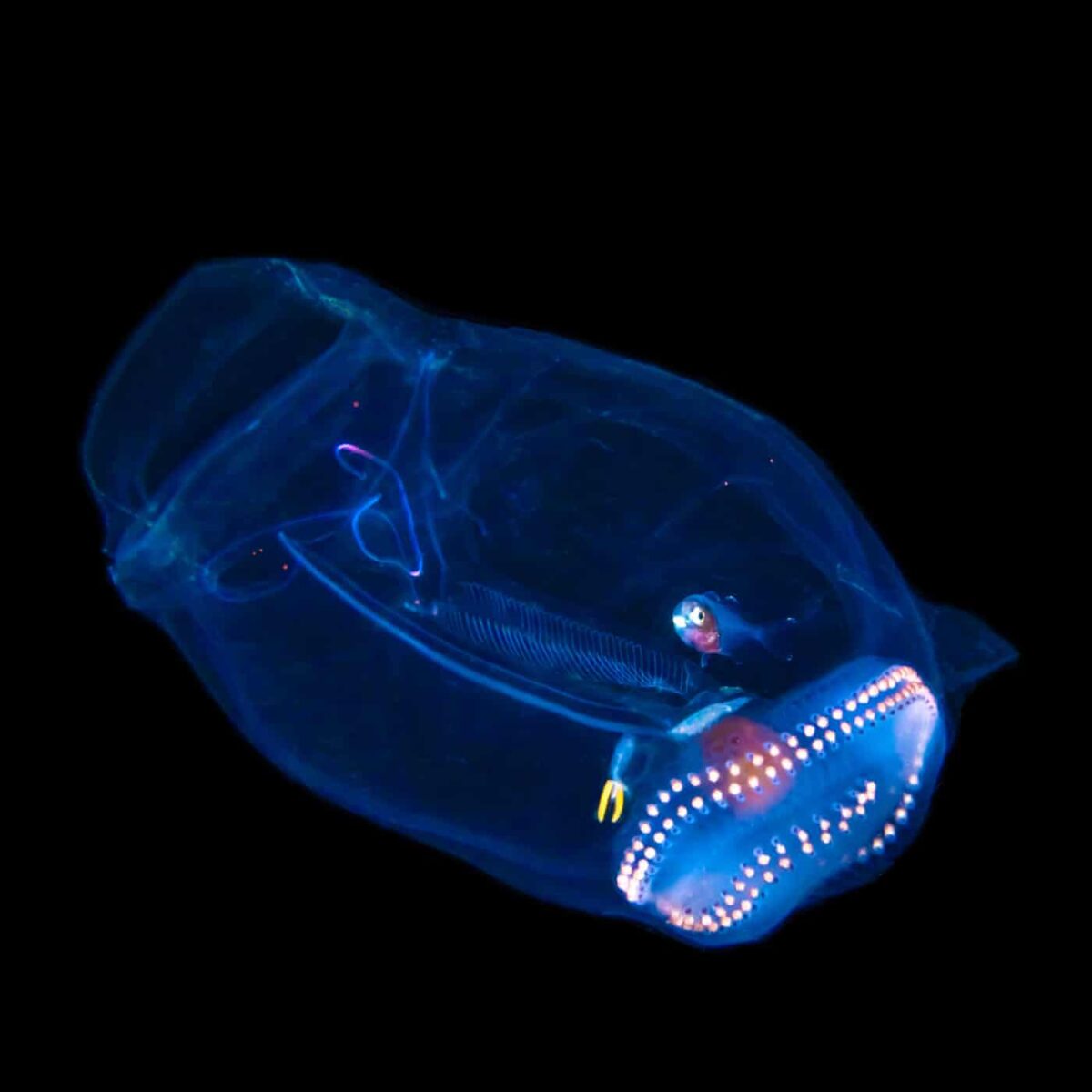Stock (vitamines, small material
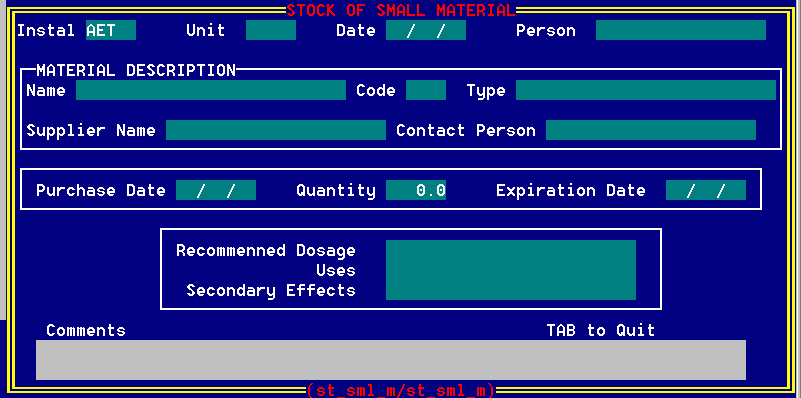
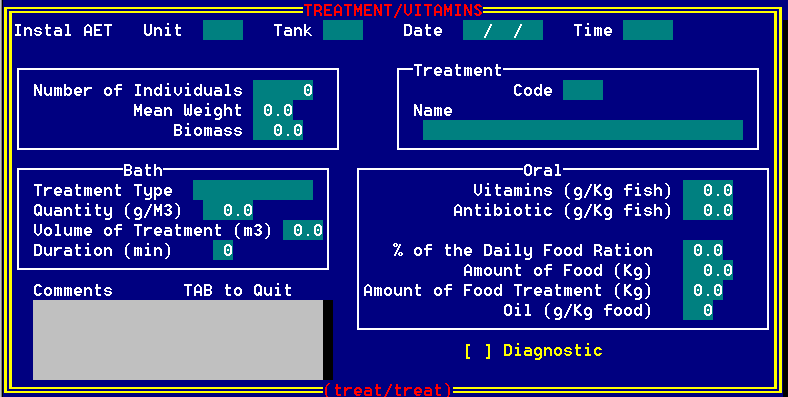
Daily – Tanks
Data unique to a tank, as opposed to a tank in a circuit are entered into the database using this screen mask..

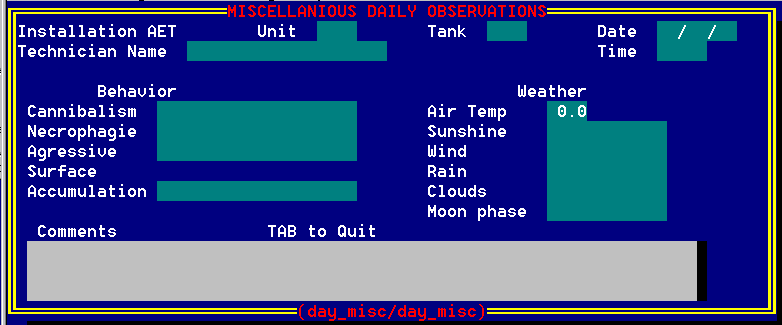
Installation
An installation is defined with basic information (i.e. name, address, legal status, geographical location, etc.) which usually remains static.
Aquaculture Information Management
Aquaculture Information Management (AIM) is a database system which provides data entry masks and file management for 60 files. It is designed to store data, perform simple calculations and interface with spread sheets (see SAP).
The goal of this software is to organize production data in order to better manage and simulate an aquaculture installation. As aquaculture becomes a more visible activity it is vulnerable to mis-information, regulations and controversy. Detailed information can resolve many questions and provide assistance for consensus building.
The following “screen shots” illustrate the application and provide information concerning production data and methods.
Main Menu
Most aquaculture installations have basic functions. Although the names and procedure can vary, the functions remain similar. We grouped these functions and tasks into :
Installation – Defining a site and its basic material
Daily – Biological Production
Art/Rot/Alg – Production of artemia, rotifers, algae,
Reproduction – Reproduction processes
Occasional – Occasional and non-production activities
Simulation – Simulation options
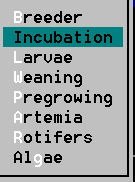

File Control
All data entry mask are accompanied by a control window, shown below. This menu permits the users to perform operation upon the data file

Operations include : Add – add a record, Beg – go to beginning of file, Copy – copy the current record, Del – delete current record, End – go to the end of the file, Find – locate and list specific records, Next – skip to next record, Prev – skip back one record, Quit – quit and return to main menu.
Units
Units, or circuits are a group of tanks connected to each other, usually via a water circuit. A unit usually produces the same animals. In our example there are 8 unit types : Breeders, Incubation, Larvae, Weaning, Pre-growing, Artemia, Rotifers and Algae.
Tanks
Your content goes here. Edit or remove this text inline or in the module Content settings. You can also style every aspect of this content in the module Design settings and even apply custom CSS to this text in the module Advanced settings.
Tanks - Daily
Data unique to a tank, as opposed to a tank in a circuit are entered into the database using this screen mask..
Larva - Daily
Your content goes here. Edit or remove this text inline or in the module Content settings. You can also style every aspect of this content in the module Design settings and even apply custom CSS to this text in the module Advanced settings.
Movement
The movement of fish from once tank to another is a common problem as it often entails separating and mixing of different lots. Often a new lot is formed from selected individuals of different lots based upon their size, mean weight or other criteria. Tracking these operations is simplified using unique batch numbers for source and destination
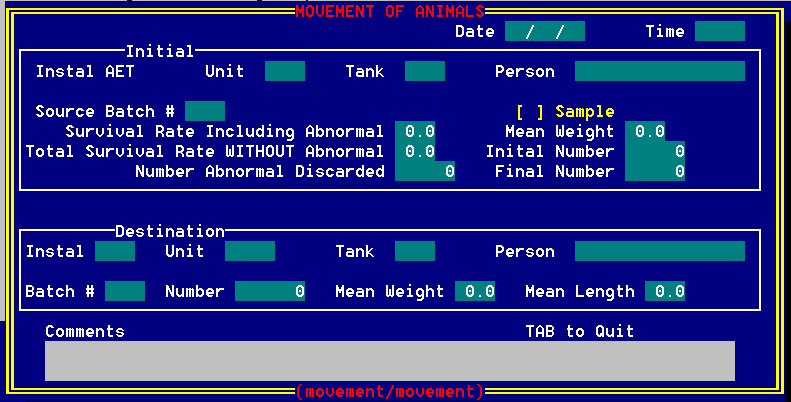
Miscellaneous
This screen is provided to record observations which are general in nature.
Enrichment Alimentaire
If a food supply is enriched with vitamins or other products the information (time, tank, etc.) is recorded to the food enrichment data file.
Artemia / Rotifers / Algae Production
any aquaculture farms produce live foods for their own larvae. The production of these micro-organisms is a process, not unlike raising fish. For example, artemia production requires several steps, decapulation, enriching their food supply, hatching and distribution to the larva production tanks, for consumption. Rotifers, like artemia, are produced for larva consumption. The production of these micro-organisms is recorded using the following two screen masks.
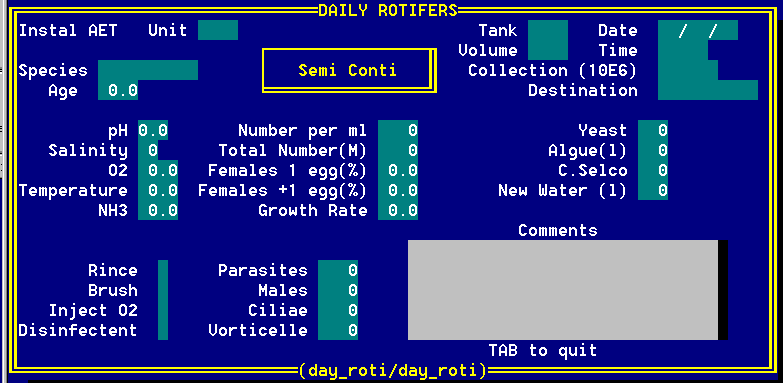
Artemia – Decapulation
The decapulation of artemia requires several steps depending upon different factors including the artemia type (A0 or A1), supplier and cysts per kilogram.
Artemia – Enrichment
Enrichment of artemia entails controlling the environment and noting what type of enrichment is used and under what conditions.
Artemia – Hatching
Sampling the Artemia during hatching provides data concerning the number hatched, the hatching rate and time they occurred.
Artemia – Request
This screen is used to “order” artemia from the production center. Commands for artemia within an aquaculture installation are centralized so those responsible for artemia production can anticipate demand.
Artemia – Supplies
This form is use as a “bill of delivery” for recording the delivery of artemia to the different production systems.
Rotifer – Enrichment
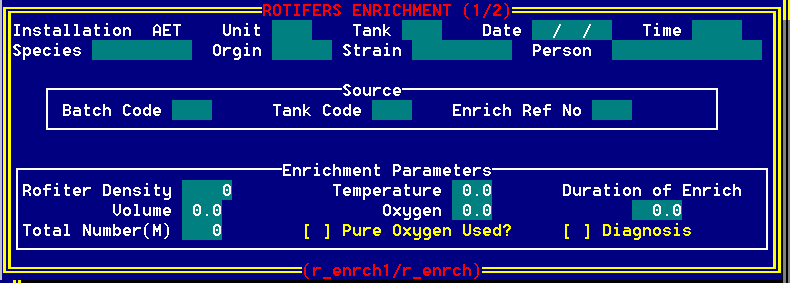
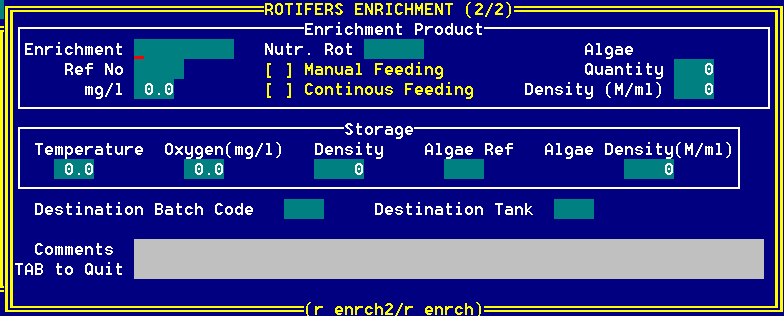
Reproduction
Reproduction is divided into several steps : induction of females, spawning, collection of eggs and filling the incubator.
Collecting the eggs and filling the incubator is required as eggs are spawned thus a system of sub-groups or “sub-batch numbers” is designed in order to form a “batch number”.
Induction
The induction process is recorded for posterity and management. Females are usually moved to an induction tank whe they can be observed during the spawning.
Spawning
As eggs are produced observations and results are recorded using this screen mask. The time of the observation is noted as the situation evolves. Eggs are collected and processed (discarded, sold or incubated), those that are retained are assigned a sub-batch number. Once the incubator is full, the group or lot, is assigned a batch number which is used to follow the lot throughout the production cycle.
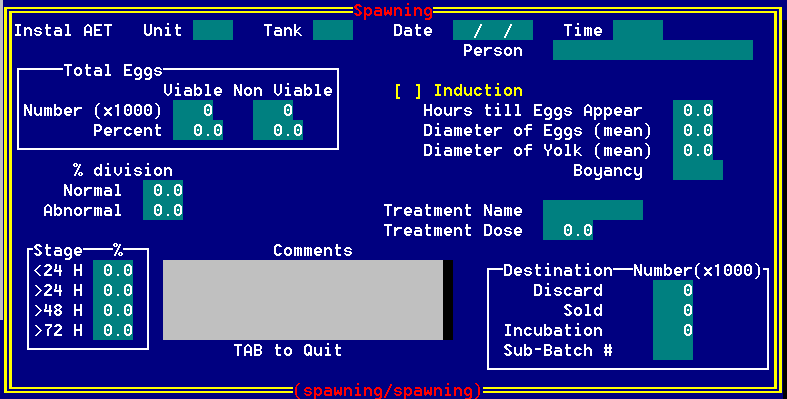
Fill Incubator
As the eggs are collected they are placed in an incubation tank. As eggs hatch larva are controlled to provide an accurate data concerning the spawning and hatching processes. The first screen is used to store data concerning the incubator and the eggs while the second screen mask is concerned with the hatching and survival of the larvae.
Occasional
ccasional and non-production activities groups several activities. The movement of fish from one tank to another, diagnosis and treatment . Also products and services purchased by the installation such as Food, Enrichments, Medicines, Vitamins, Disinfectants and Small Material. This section also stores information concerning the installation’s infrastructure and functioning such as Fixed Costs, Salaries and Investments.
Slaries
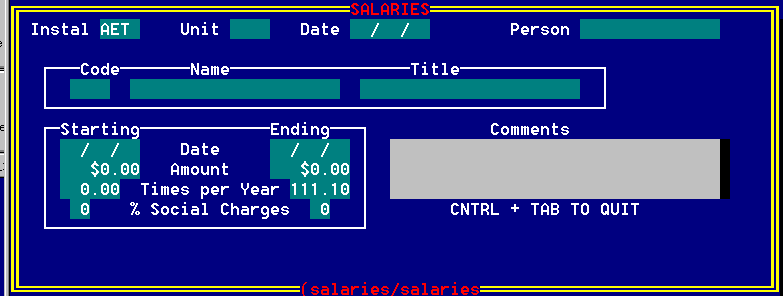
Simulate
This section is under construction
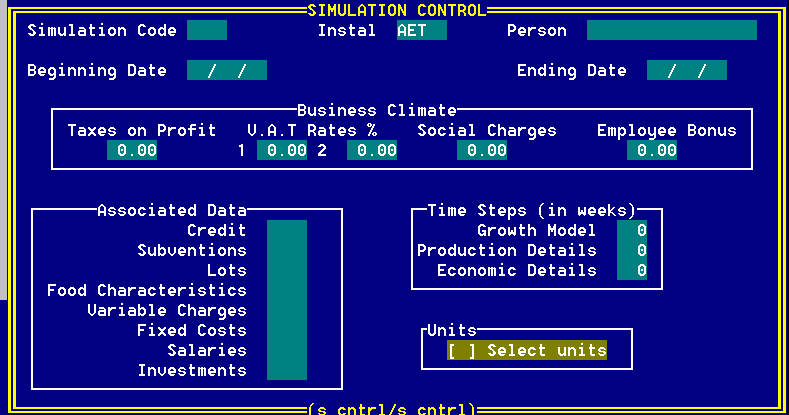
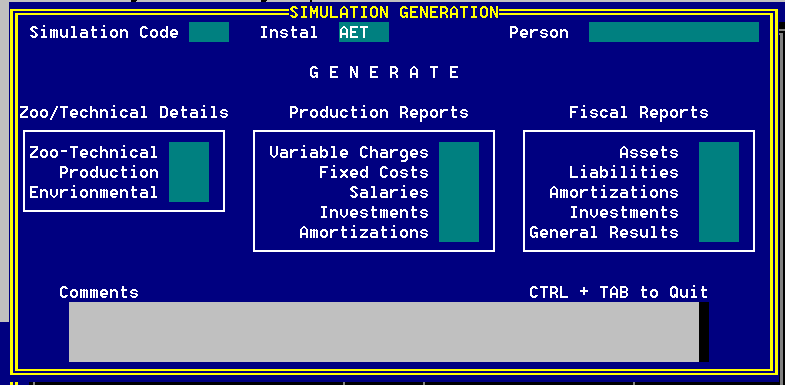
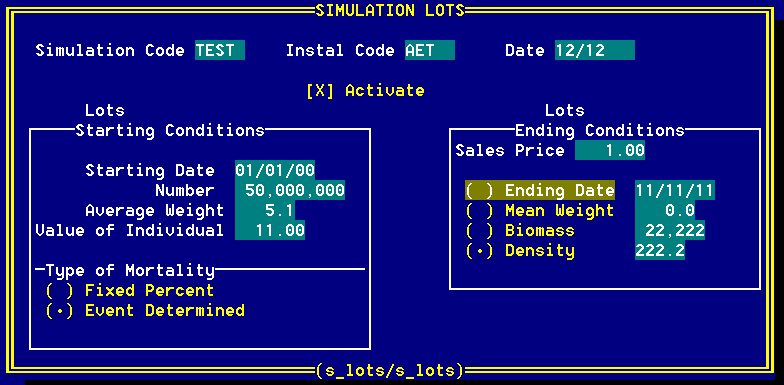
Conclusion
Deaths can occur in any tank. The above screen is for recording all deaths, no matter where they occur
Daily (top)
Several processes can be performed during the production of rotifers : they are sampled, collected, the environment controlled, etc. Productions is either Semi-continuous or batch.
Algae (top)
This section is under construction.
Diagnosis (top)
The diagnosis file records data concerning the evaluation of health problems. Case numbers are assigned, individuals are sampled, diagnosed, values recorded and comments noted.
Treatment (top)
Treatment such as vitamins, antibiotic, etc are recorded in the treatment file. Treatments can be performed at the circuits, tanks or individual level in solution or orally.
Consumables (top)
Consumables groups products and services which are purchased by the installation. Consumables are divided into two groups infrastructure which include Fixed Costs, Salaries, Investments and production consumables such as : Food , Details of Food, Enrichments, Medicines, Vitamins, Disinfectants, Small Material.
This information is important for accounting and simulation of production as it provides a detailed list of charges and obligations credited to the installation..
Fixed Costs (top)
Fixed costs are divided into 13 categories : Assurance (livestock), Assurance (required), Energy, Gasoline, Accounting Expenses, Education Expenses, Reception Expenses, Travel Expenses, Miscellaneous (water, O2, etc…), Office Supplies, Repair, Transport for Purchases and Taxes & Charges.
Salaries (top)
Salaried employees are noted here. This is data file and screen mask are available in order to obtain information concerning employee cost. This information is necessary for simulation and the calculation of certain production costs.
Investments (top)
Investments lists material which is required for production. Equipment is grouped into 8 categories : 1) Ocean Structure, 2) Ocean Equipment, 3) Construction, 4) Material for Functioning, 5) Production Control, 6) Security and Sanitary, 7) Processing & Commercial Equipment and 8) General Equipment. Each piece of equipment is stored with its purchase date, unit price, number of units, length of amortization and type of VAT to be applied.
Administration (top)
Tools for optimizing and controlling the databases.
This section is under construction
Consumables – Food (top)
Food is divided into 2 sections the stock, or inventory and the details of the food. The stock section stores information concerning the food supplier, purchase date, price and the foods basic composition.
Consumables – Details of Food (top)
The food details describes the composition of the food. These details permit the calculation of nutrients distributed to the fish. This information could provide invaluable when analyzing growth and health performance of the chaptel. For more information concerning nutrition see Nutrition.
Consumables – Enrichment (top)
This file stores information concerning food enrichments, its usage and purchase information.
Consumables – Medicines (top)
Medicines, like food and enrichments, are purchased and stored until required. This file maintains a list of all the medicines in stock and their recommended uses.
Consumables – Vitamins (top)
Vitamins are also stocked in inventory until required. This file is used to store all the information concerning vitamins, their use and the amount remaining in stock.
Consumables – Disinfectants (top)
Another type of consumable are disinfectants.
Consumables -Small Material (top)
Small material groups all products which are not specifically grouped into the other consumables such as food, vitamins, disinfectants, etc.
Simulation (top)
The object of a database is to store production data in order to better understand and manage an aquaculture farm. An important tool is the ability to simulate production into the future without experimenting with current production processes. This section is designed to illustrate how one might simulate an aquaculture farm using real production data combined with various scenarios and models. The goal is to develop a tool which could signal potential problems and obstacles before they limit production and reduce profit.
Control (economic) (top)
Control is designed to activate or dis-activate major components of the simulation. For example a simulation could include taxes, subventions, investments, etc. Or just calculate the growth rate and food cost of a lot.
This screen lets the users select which reports to generate or print.
Production (top)
This screen defines the lots and how they are to be simulated and what are the simulation stopping conditions.
Food (top)
Simulating production must also consider food and feeding strategies. Calculations could be based upon feeding tables, (dynamic) ratios, inventory optimization or many other criteria and relations.
This section is under construction
Growth Models (top)
A model must be considered in its globality. They are based upon a certain data set and experimental environment. Their results and accuracy are based upon the data received and the complexity of the process being modeled. Simulating fish growth, production of waste products and other biological processes is quite complex. The many different interactions (physical / biological) occurring render models more inaccurate and results are difficult to repeat.
This section is under construction
Geo-Physic (top)
Changes in the physical environment are common. Decreases in temperature, or current could adversely effect production at crucial moments. The ability to change and test climatic scenarios,
This section is under construction
, NHx, CO2, etc. (top)
This section controls strategies and models effecting biological pollution. Metabolic modeling is not just reserved for growth. Biological processes must be anticipated, calculated and compensated for.
This section is under construction
Fixed Costs (top)
Simulating fixed costs could entail several different stratgies. Such as fixed cost which don’t vary or which vary as a percentages of production costs or tonnage produced. Fixed costs coud also vary within in fixed limits in order to find and test critical constraints.
This section is under construction
Investments (top)
Invstments, like fixed costs, could be simulated using several different methods.
This section is under construction
Simulate (top)
This section is under construction
s can occur in any tank. The above screen is for recording all deaths, no matter where they occur.
Enrichment (top)
If a food supply is enriched with vitamins or other products the information (time, tank, etc.) is recorded to the food enrichment data file.
Miscellaneous (top)
This screen is provided to record observations which are general in nature.
Daily – Tanks (top)
Data unique to a tank, as opposed to a tank in a circuit are entered into the database using this screen mask..
Units (top)
Units, or circuits are a group of tanks connected to each other, usually via a water circuit. A unit usually produces the same animals. In our example there are 8 unit types : Breeders, Incubation, Larvae, Weaning, Pre-growing, Artemia, Rotifers and Algae.
Artemia / Rotifers / Algae Production (top)
Many aquaculture farms produce live foods for their own larvae. The production of these micro-organisms is a process, not unlike raising fish. For example, artemia production requires several steps, decapulation, enriching their food supply, hatching and distribution to the larva production tanks, for consumption.
Artemia – Decapulation (top)
The decapulation of artemia requires several steps depending upon different factors including the artemia type (A0 or A1), supplier and cysts per kilogram.
Artemia – Enrichment (top)
Enrichment of artemia entails controlling the environment and noting what type of enrichment is used and under what conditions.
rtemia – Hatching (top)
Sampling the Artemia during hatching provides data concerning the number hatched, the hatching rate and time they occurred.
Artemia – Request (top)
This screen is used to “order” artemia from the production center. Commands for artemia within an aquaculture installation are centralized so those responsible for artemia production can anticipate demand.
Artemia – Supplies (top)
This form is use as a “bill of delivery” for recording the delivery of artemia to the different production systems.
Rotifer – Enrichment (top)
Rotifers, like artemia, are produced for larva consumption. The production of these micro-organisms is recorded using the following two screen masks.
aily (top)
Several processes can be performed during the production of rotifers : they are sampled, collected, the environment controlled, etc. Productions is either Semi-continuous or batch.
Algae (top)
This section is under construction.
Reproduction (top)
Reproduction is divided into several steps : induction of females, spawning, collection of eggs and filling the incubator.
Collecting the eggs and filling the incubator is required as eggs are spawned thus a system of sub-groups or “sub-batch numbers” is designed in order to form a “batch number”.
Induction (top)
The induction process is recorded for posterity and management. Females are usually moved to an induction tank whe they can be observed during the spawning.
Spawning (top)
As eggs are produced observations and results are recorded using this screen mask. The time of the observation is noted as the situation evolves. Eggs are collected and processed (discarded, sold or incubated), those that are retained are assigned a sub-batch number. Once the incubator is full, the group or lot, is assigned a batch number which is used to follow the lot throughout the production cycle.
Fill Incubator (top)
As the eggs are collected they are placed in an incubation tank. As eggs hatch larva are controlled to provide an accurate data concerning the spawning and hatching processes. The first screen is used to store data concerning the inbator and the eggs while the second screen mask is concerned with the hatching and survival of the larvae.
Occasional (top)
Occasional and non-production activities groups several activities. The movement of fish from one tank to another, diagnosis and treatment . Also products and services purchased by the installation such as Food, Enrichments, Medicines, Vitamins, Disinfectants and Small Material. This section also stores information concerning the installation’s infrastructure and functioning such as Fixed Costs, Salaries and Investments.
Movement (top)
he movement of fish from once tank to another is a common problem as it often entails separating and mixing of different lots. Often a new lot is formed from selected individuals of different lots based upon their size, mean weight or other criteria. Tracking these operations is simplified using unique batch numbers for source and destination.
Diagnosis (top)
The diagnosis file records data concerning the evaluation of health problems. Case numbers are assigned, individuals are sampled, diagnosed, values recorded and comments noted.
reatment (top)
Treatment such as vitamins, antibiotic, etc are recorded in the treatment file. Treatments can be performed at the circuits, tanks or individual level in solution or orally.
Consumables (top)
onsumables groups products and services which are purchased by the installation. Consumables are divided into two groups infrastructure which include Fixed Costs, Salaries, Investments and production consumables such as : Food , Details of Food, Enrichments, Medicines, Vitamins, Disinfectants, Small Material.
This information is important for accounting and simulation of production as it provides a detailed list of charges and obligations credited to the installation..
Fixed Costs (top)
Fixed costs are divided into 13 categories : Assurance (livestock), Assurance (required), Energy, Gasoline, Accounting Expenses, Education Expenses, Reception Expenses, Travel Expenses, Miscellaneous (water, O2, etc…), Office Supplies, Repair, Transport for Purchases and Taxes & Charges.
Salaries (top)
Salaried employees are noted here. This is data file and screen mask are available in order to obtain information concerning employee cost. This information is necessary for simulation and the calculation of certain production costs.
Investments (top)
Investments lists material which is required for production. Equipment is grouped into 8 categories : 1) Ocean Structure, 2) Ocean Equipment, 3) Construction, 4) Material for Functioning, 5) Production Control, 6) Security and Sanitary, 7) Processing & Commercial Equipment and 8) General Equipment. Each piece of equipment is stored with its purchase date, unit price, number of units, length of amortization and type of VAT to be applied.
Administration (top)
Tools for optimizing and controlling the databases.
This section is under construction
Consumables – Food (top)
Food is divided into 2 sections the stock, or inventory and the details of the food. The stock section stores information concerning the food supplier, purchase date, price and the foods basic composition.
Consumables – Details of Food (top)
The food details describes the composition of the food. These details permit the calculation of nutrients distributed to the fish. This information could provide invaluable when analyzing growth and health performance of the chaptel. For more information concerning nutrition see Nutrition.
Consumables – Enrichment (top)
This file stores information concerning food enrichments, its usage and purchase information.
Consumables – Medicines (top)
Medicines, like food and enrichments, are purchased and stored until required. This file maintains a list of all the medicines in stock and their recommended uses.
Consumables – Vitamins (top)
Vitamins are also stocked in inventory until required. This file is used to store all the information concerning vitamins, their use and the amount remaining in stock.
Consumables – Disinfectants (top)
Another type of consumable are disinfectants.
Consumables -Small Material (top)
Small material groups all products which are not specifically grouped into the other consumables such as food, vitamins, disinfectants, etc.
Simulation (top)
The object of a database is to store production data in order to better understand and manage an aquaculture farm. An important tool is the ability to simulate production into the future without experimenting with current production processes. This section is designed to illustrate how one might simulate an aquaculture farm using real production data combined with various scenarios and models. The goal is to develop a tool which could signal potential problems and obstacles before they limit production and reduce profit.
Control (economic) (top)
Control is designed to activate or dis-activate major components of the simulation. For example a simulation could include taxes, subventions, investments, etc. Or just calculate the growth rate and food cost of a lot.
This screen lets the users select which reports to generate or print.
Production (top)
This screen defines the lots and how they are to be simulated and what are the simulation stopping conditions.
Food (top)
Simulating production must also consider food and feeding strategies. Calculations could be based upon feeding tables, (dynamic) ratios, inventory optimization or many other criteria and relations.
This section is under construction
Growth Models (top)
A model must be considered in its globality. They are based upon a certain data set and experimental environment. Their results and accuracy are based upon the data received and the complexity of the process being modeled. Simulating fish growth, production of waste products and other biological processes is quite complex. The many different interactions (physical / biological) occurring render models more inaccurate and results are difficult to repeat.
This section is under construction
Geo-Physic (top)
Changes in the physical environment are common. Decreases in temperature, or current could adversely effect production at crucial moments. The ability to change and test climatic scenarios,
This section is under construction
, NHx, CO2, etc. (top)
This section controls strategies and models effecting biological pollution. Metabolic modeling is not just reserved for growth. Biological processes must be anticipated, calculated and compensated for.
This section is under construction
Fixed Costs (top)
Simulating fixed costs could entail several different stratgies. Such as fixed cost which don’t vary or which vary as a percentages of production costs or tonnage produced. Fixed costs coud also vary within in fixed limits in order to find and test critical constraints.
This section is under construction
Investments (top)
Invstments, like fixed costs, could be simulated using several different methods.
This section is under construction
Simulate (top)
This section is under construction
Conclusion (top)
